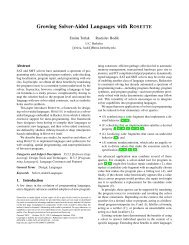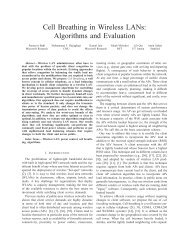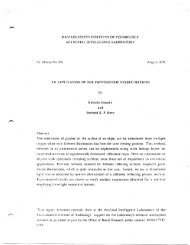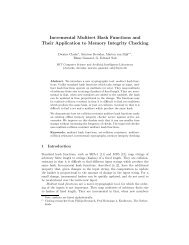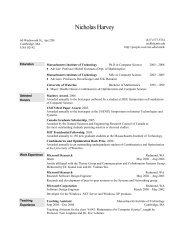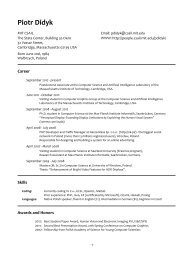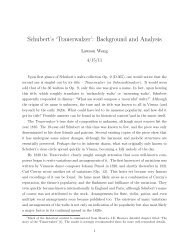On-chip Networks for Manycore Architecture Myong ... - People - MIT
On-chip Networks for Manycore Architecture Myong ... - People - MIT
On-chip Networks for Manycore Architecture Myong ... - People - MIT
You also want an ePaper? Increase the reach of your titles
YUMPU automatically turns print PDFs into web optimized ePapers that Google loves.
Characteristic<br />
Configuration<br />
Topology<br />
8x8 2D MESH<br />
Link configuration (u, b) = (1,0), (0,2)<br />
(2,0), (1,2), (0,4)<br />
Routing<br />
DOR-XY and DOR-YX<br />
VC output multiplexing<br />
None,<br />
Matching maximum bandwidth<br />
Per-hop latency<br />
1 cycle<br />
Virtual channels per port 4<br />
Flit bu↵ers per VC 4<br />
Average packet length (flits) 8<br />
Tra c workload transpose, bit-complement,<br />
shu✏e, uni<strong>for</strong>m-random<br />
profiled H.264 decoder<br />
Burstiness model<br />
Markov modulated process<br />
Warmup cycles 20,000<br />
Analyzed cycles 100,000<br />
Table 3.2: Simulation details <strong>for</strong> BAN and unidirectional networks<br />
of bandwidth allocation to estimate the impact on architectures where a dead cycle<br />
is required to switch the link direction.<br />
Although the bidirectional routing technique applies to various oblivious routing<br />
algorithms, we have, <strong>for</strong> evaluation purposes, focused on Dimension Ordered Routing<br />
(DOR), the most widely implemented oblivious routing method. While our experiments<br />
included both DOR-XY and DOR-YX routing, we did not see significant<br />
di↵erences in the results, and consequently report only DOR-XY results. In all of our<br />
experiments, the router was configured <strong>for</strong> four virtual channels per ingress port under<br />
a dynamic virtual channel allocation regimen. The e↵ect of multiplexing virtual<br />
channels in front of the crossbar switches was also examined.<br />
3.4.2 Non-bursty Synthetic Tra c<br />
Figure 3-7 shows the throughput in the unidirectional and bidirectional networks<br />
under non-bursty tra c. When tra c is consistent, the improvement o↵ered by<br />
bidirectional links depends on how symmetric the flows are. <strong>On</strong> the one extreme,<br />
bit-complement, which in steady state is entirely symmetric when routed using DOR<br />
58



